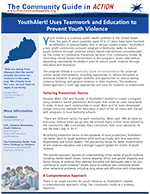YouthAlert! Uses Teamwork and Education to Prevent Youth Violence
Summary
 A Kentucky-based youth violence prevention program used universal school-based interventions recommended by the Community Preventive Services Task Force as the foundation for a state-wide campaign to reduce and prevent youth violence. After reaching thousands of teens across Kentucky, the program plans to expand nationwide and offer evidence-based, tailored approaches for teaching violence prevention. (Released 2017)
A Kentucky-based youth violence prevention program used universal school-based interventions recommended by the Community Preventive Services Task Force as the foundation for a state-wide campaign to reduce and prevent youth violence. After reaching thousands of teens across Kentucky, the program plans to expand nationwide and offer evidence-based, tailored approaches for teaching violence prevention. (Released 2017)
Lessons Learned
- Modify programs to suit local needs. There are many different factors that contribute to youth violence, and not every program is one-size-fits-all. Tailor educational programs for the target audience, adapting for participants’ age, regional requirements, and sources of violence endemic to that community.
- Use all available resources. Instead of trying to start new studies or programs from scratch, use information that’s readily accessible to have a good foundation. Having nationally-recognized, research-based evidence as a starting point provides both recognition and credibility.
- Treat the whole problem. Many efforts to reduce violence don’t take socioeconomic, ethnic, sex, and mental wellness influences into account when creating new programs. In order to succeed, programs must treat the individual as well as the community.
Story
The program follows a Community Guide recommendation for universal school-based interventions, including approaches to reduce disruptive or antisocial behavior in younger students and approaches to reduce dating violence, bullying, and general violence in older students. This evidence-based approach is both age appropriate and easy for students to understand.
Tailoring Prevention Tactics
Douglas Wain, CEO and founder of YouthAlert! wanted to create a program using evidence-based prevention techniques that could be used nationwide. In order to best reach communities in need, Wain and his team developed unique instructor manuals for educators in each of the 50 states and started with programs in local Kentucky schools.
“There are different tactics for each community,” Wain said. “We do have an instructor manual when we go into the schools that’s a little more tailored to the community. [We incorporate] their curriculum, their local standards, to see the exact way to do it.”
By tailoring prevention tactics to the standards of local jurisdictions, YouthAlert! can better reach its target audience while working closely with local education departments and school leaders. This partnership allows for better dissemination of anti-violence education and a stronger support system for victims of youth violence.
This tailored approach requires an understanding of the causes of youth violence, including mental health issues, income disparity, ethnic and sex disparity, and family history of violence. Poor parental discipline and delinquent peers can also contribute to youth violence.2 Youths prone to violence also commonly exhibit other behavioral problems, including drug abuse and difficulties with schoolwork.
A Comprehensive Approach
There is no single solution for youth violence, so YouthAlert! created a comprehensive approach, citing The Community Guide as a primary resource.
“YouthAlert! believes there’s already enough evidence-based violence and bully prevention [strategies] out there to cure violence. We already know how to do it. We’re just applying it, all the information that’s there,” Wain said. “We’re not reinventing the wheel; we’re taking the thousands of wheel designs that we know work and applying them to our model.”
YouthAlert! incorporates several skills included in the universal school-based programs review. In addition to manuals and handouts educating youth about violence, the program also promotes mental well-being and self-awareness.
YouthAlert! focuses on adolescents aged 10-24, empowering them to prevent violence in school, at home, and in their communities.
“We’re not just a comprehensive violence prevention program,” Wain said. “We consider ourselves a comprehensive youth health program and a comprehensive youth program.”
Tracking Results
In order to track progress made by the YouthAlert! program, participants are expected to fill out evaluations after the program presentation, along with a pre- and post-test to go over lessons learned.
The pre-test/post-test assessment has shown significant learning progress. YouthAlert! boasts a 74% gain score among the middle and high school students that completed the five-question assessment.3
The program’s evaluation assessments show positive improvement as well. Of more than 10,000 Kentucky youth served and surveyed by the program, 96.2% of students said the presentation will help prevent them from committing an act of violence. One hundred percent of teachers said the presentation could make a difference in a positive way, and that they would recommend the program to other organizations.
1Task Force on Community Preventive Services. A recommendation to reduce rates of violence among school-aged children and youth by means of universal school-based violence prevention programs. Am J Prev Med 2007;33(2S):S112-13.
2Wasserman G, Keenan K, Tremblay R, et al. Risk and protective factors of child delinquency. Washington DC: U.S. Department of Justice, 2003.
3YouthAlert! (YA!) Home Page. (2015) [retrieved January 03, 2017] Available from http://youthalert.us/
More Information
CDC, Violence Prevention, Youth Violence
Community Preventive Services Task Force findings referred to in this story:
The Community Guide: Task Force Findings on Violence Prevention